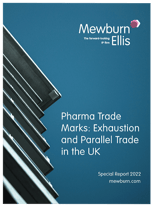
Recent case law of the Court of Justice of the European Union (CJEU) has clarified how the provisions relating to the packaging and repackaging of medicinal products, specifically, the EU Medicines Directive as amended by the Falsified Medicines Directive, should be interpreted and applied in the context of the parallel trade of pharmaceutical products within the EU.
Exhaustion and parallel imports
Once goods bearing a trade mark have been placed on the market in the European Economic Area (EEA), either by a trade mark proprietor, or with their consent, subject to fairly strict conditions, the doctrine of exhaustion prevents the proprietor from objecting to or exercising control over further dealings in those goods based on EU IP rights. Such further dealings may include the parallel importation of those goods, i.e., where the goods are purchased in one country (where they have been sold by the proprietor) and then sold in another. Given the significant differences in the pricing of medicinal and pharmaceutical products across the different countries in the EU, there is a considerable market for the parallel import of these goods.
When can the proprietor object to repackaging, relabelling and rebranding of their goods?
The case law of the CJEU, most notably in Bristol-Myers Squibb and Others v Paranova A/S (Case C-427/93), has made clear that an importer must comply with the following conditions, otherwise the proprietor has grounds to object:
- Repackaging must be necessary to market the product;
- There must be no effect on the original condition of the product;
- The new packaging must clearly identify the manufacturer and the importer;
- The presentation of the repackaged product must not damage the reputation of the trade mark; and
- The importer must give notice to the trade mark owner before the repackaged product is put on sale, and supply a sample of the repackaged product if requested.
EU Medicines Directive and the Falsified Medicines Directive (FMD)
There are a number of specific rules and regulations relating to the packaging of pharmaceutical products, which arise from the nature of the goods and their potential to be harmful to their users if proper precautions for tampering and modification are not in place.
Many of these rules are set out in the EU Medicines Directive (2001/83/EC), as amended by the FMD (2011/62/EU), and Delegated Regulation 2016/161, which introduced additional requirements for the packaging of medicinal products. They include the following important provisions:
- The outer packaging or, if there is no outer packaging, the immediate packaging of a medicinal product must include two main safety measures:
- a unique identifier, which enables “wholesale distributors and persons authorised or entitled to supply medicinal products to the public to verify the authenticity of the medicinal product, and identify individual packs”; and
- an anti-tampering device, which allows “verification of whether the outer packaging has been tampered with”.
- The above safety measures must not be removed or covered unless the manufacturing authorisation holder verifies, prior to partly or fully removing or covering those safety features, that the medicinal product concerned is authentic and that it has not been tampered with.
- If the safety features are removed or covered, they must be replaced with safety features which are equivalent as regards the possibility to verify the authenticity, identification and to provide evidence of tampering of the medicinal product.
The cases and issues
On 17 November 2022, the CJEU gave its preliminary ruling response to three separate requests made by the national courts of Germany (Cases C‑147/20 and C‑204/20) and Denmark (Case C-224/20).
Although separate, the cases all centred around very similar issues. Specifically, all three cases concerned the extent to which a trade mark owner may rely on its rights to prevent a parallel importer from repackaging a medicinal product in new outer packaging which bears their trade mark, if the replacement of the anti-tampering device on the original packaging (as is required by the FMD) would leave visible traces.
The cases were all brought by pharmaceutical companies, including Novartis, Bayer, and Merck Sharp & Dohme, against parallel importers of pharmaceutical products, including Abacus Medicine kohlpharma, and Paranova.
Although there are some differences, the arguments of the parties can be summarised as follows.
- The parallel importers argued that in order to comply with the provisions of the Medicines Directive and the FMD, they had to open the original outer packaging of the medicinal products put onto the market by the pharmaceutical companies, which would damage the original anti-tampering device. Therefore, they claimed that it was necessary to replace the product with entirely new packaging in order to effectively market the products, as consumers would inevitably be less inclined to purchase products which had visible traces of being opened and resealed.
- On the other hand, the pharmaceutical companies sought injunctions against the repackaging of their products, arguing that a complete repackaging went beyond what was necessary in order for the products to be marketed, and therefore they were permitted to object based on their trade mark rights. They claimed that there were other and less extreme alternatives that could be used in order to comply with the provisions of the FMD, and to still ensure consumer safety. For example, the parallel importers could replace the original anti-tampering device with an equivalent security device.
The decisions
The decisions of the CJEU determine a number of important points, which are summarised below.
- Although the requirements of the Medicines Directive and the FMD will inevitably mean that the parallel importers of pharmaceutical products will have to open the original outer packaging of the products, which may leave visible traces that the packaging had been opened, this does not automatically mean that an equivalent anti-tampering device cannot be applied by the parallel importer.
- To be equivalent, the replacement anti-tampering device has to make it possible to verify, with the same effectiveness as an original anti-tampering device, that the outer packaging of a medicinal product had not been unlawfully opened between the time the medicinal product was opened by the parallel importer and when it sold to the end-consumer.
- It cannot be automatically assumed that visible traces that a pharmaceutical product had been opened and re-sealed by a parallel importer will cause such a strong resistance to the repackaged products on the part of consumers, that this would constitute an obstacle to effective access to the market. Resistance on the part of consumers has to be established with concrete evidence on a case-by-case basis.
- If it was objectively possible to relabel the product, rather than repackage it, and still be compliant with the Medicines Directive and the FMD, then the proprietor would be entitled to enforce their rights against the repackaging.
- However, if the parallel importer can establish that the existence of visible traces that the original packaging had been opened would have such an effect on a significant proportion of consumers, then the trade mark proprietors would not be able to rely on their trade mark rights to stop the repackaging of the products by the parallel importers.
Comment
These decisions of the CJEU will no doubt be seen by pharmaceutical companies as a positive development on the rules relating to the parallel trade of medicinal products.
No longer will the importers of pharmaceutical products be able to treat the provisions of the FMD as an automatic right to repackage. Even if compliance with the directives will leave visible traces that the packaging had been opened, this does not necessarily mean that the importers’ access to the market will be hindered. The importers will need to provide concrete reasons why it is necessary to repackage the product, and why they could not simply replace the security features of the packaging with new security features of equivalent effect.
This seems like a sensible interpretation of the provisions of the directives, which protects the rights of IP holders without unduly restricting the principle of free movement of goods. If importers can show that there are legitimate reasons why it is necessary to repackage the product, they will still be able to do so.
The UK position
Rebecca Anderson-Smith, Mewburn Ellis Partner and Chartered Trade Mark Attorney, comments:
The 'safety features' elements of the FMD ceased to have effect in Great Britain (England, Scotland and Wales) from 31 December 2020. This means that medicines with a marketing authorisation valid only in Great Britain do not require a unique identifier. However, the UK government encourages companies to retain a tamper evident device.
Medicines with a marketing authorisation valid in Northern Ireland require a unique identifier and a tamper evident device on each pack.
The Medicines and Medical Devices Act 2021 enables legislation covering human and veterinary medicines and medical devices in the UK to be amended in future. This could lead to the establishment of a national system based on unique identifiers, enabling medicines to be authenticated and identified if tampered with. The UK government is currently exploring ways to update the regulation of medical devices.
A detailed analysis of the current law and practice on exhaustion and parallel trade in the context of pharmaceutical trade marks in the UK is available in our Special Report ‘Pharma Trade Marks: Exhaustion and Parallel Trade in the UK’.
|
Joe is an associate and a member of our trade mark team. He has an LLB Law degree from the University of Manchester and LLM in Professional Legal Practice from the University of Law, which encompassed the Legal Practice Course. At both undergraduate and postgraduate level, Joe completed modules on Intellectual Property law, which focussed on trade mark law and practice. Joe previously worked in the Business Crime and Regulation department at a solicitors’ firm on a high-profile criminal case.
Email: joe.mcalary@mewburn.com
Sign up to our newsletter: Forward - news, insights and features
Our people
Our IP specialists work at all stage of the IP life cycle and provide strategic advice about patent, trade mark and registered designs, as well as any IP-related disputes and legal and commercial requirements.
Our peopleContact Us
We have an easily-accessible office in central London, as well as a number of regional offices throughout the UK and an office in Munich, Germany. We’d love to hear from you, so please get in touch.
Get in touch



